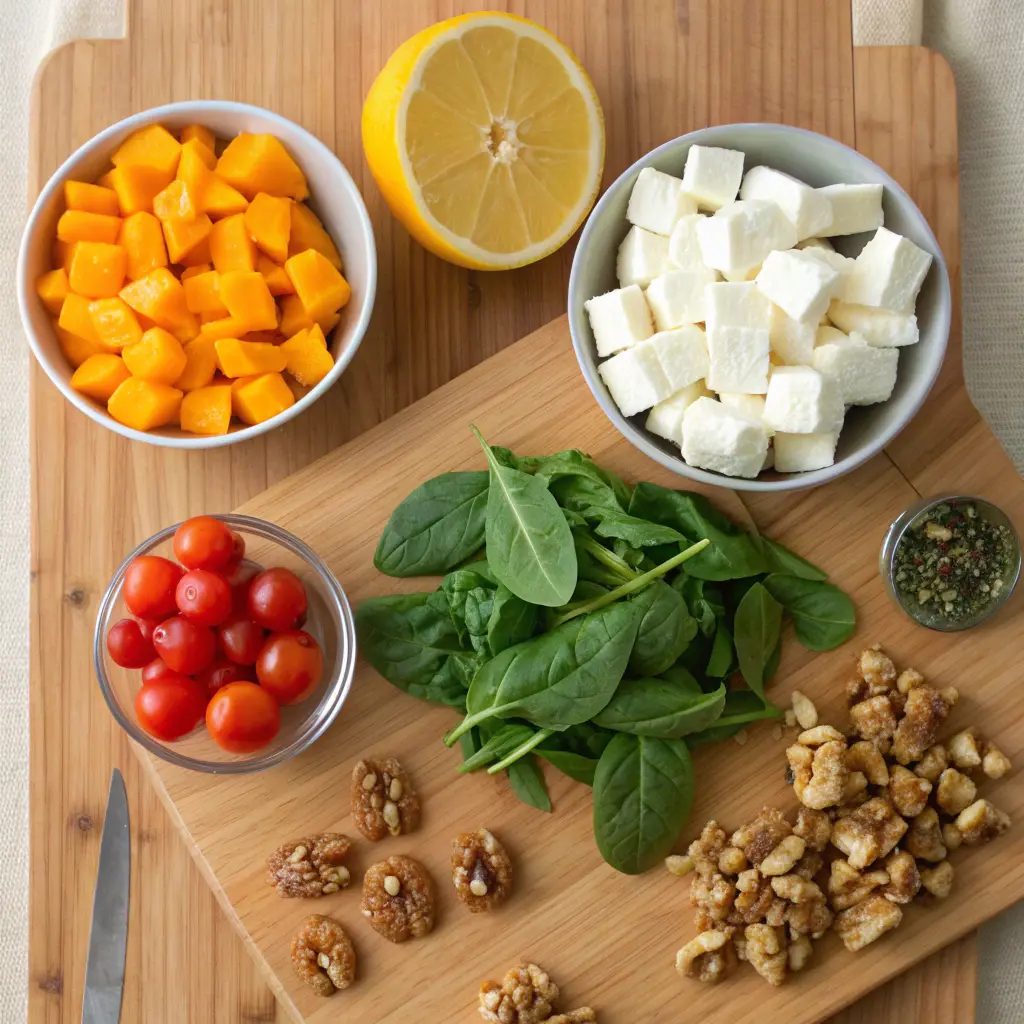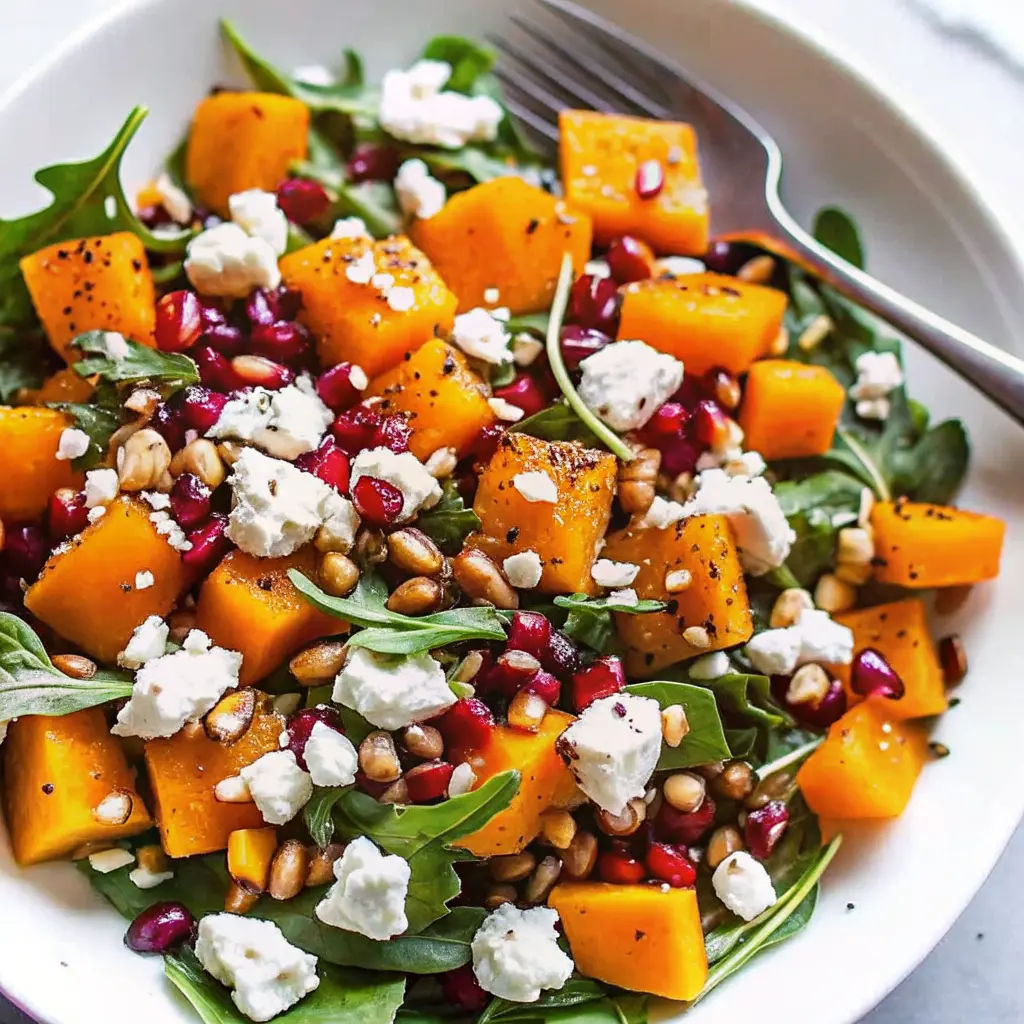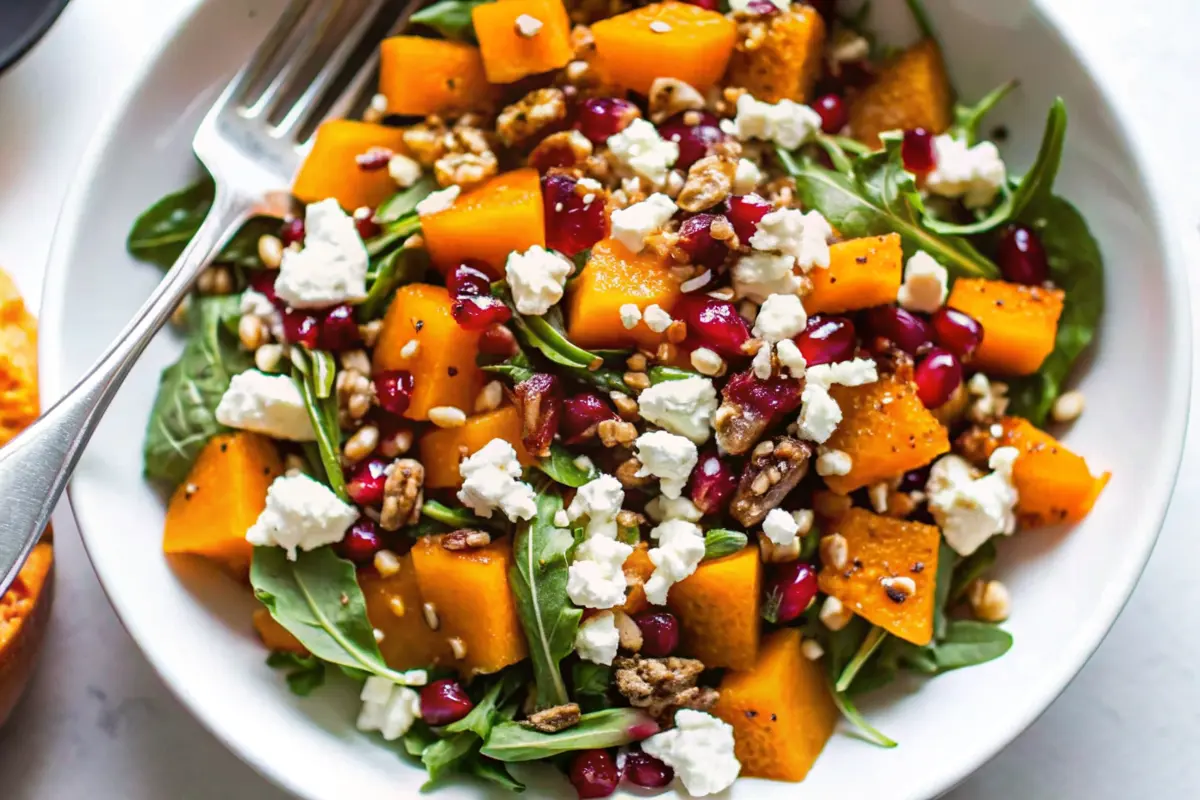Introduction
Butternut Squash Feta Salad is a vibrant, flavorful dish that perfectly captures the essence of fall. The sweet, caramelized butternut squash pairs beautifully with tangy feta, fresh greens, and crunchy nuts, creating a salad that’s both comforting and elegant.
Why Butternut Squash Feta Salad Works
The genius of this salad lies in the way flavors and textures balance one another:
- Sweetness: Roasted squash develops caramelized edges that taste naturally sweet.
- Saltiness: Feta cheese adds a sharp, tangy bite that cuts through the sweetness.
- Crunch: Seeds or nuts deliver texture that makes every bite satisfying.
- Freshness: Peppery greens like arugula or kale bring brightness to the dish.
- Balance: A simple vinaigrette ties everything together with acidity, fat, and subtle sweetness.
This contrast makes the salad not only delicious but also versatile. It can be served warm, at room temperature, or cold — each version offering a slightly different experience.
Ingredients for Butternut Squash Feta Salad
Here’s what you’ll typically need for Butternut Squash Feta Salad:
For the Salad:
- 1 medium butternut squash (about 2–3 cups cubed)
- 3 cups fresh greens (arugula, baby spinach, or kale)
- 1 cup crumbled feta cheese (or whipped feta)
- ½ cup pomegranate arils (optional, for sweetness and color)
- ¼ cup toasted nuts or seeds (walnuts, pistachios, or pepitas)
- ¼ cup dried cranberries or chopped dates (optional)
- 2 tablespoons fresh herbs (parsley, mint, or dill)
For the Dressing:
Maple-Mustard Vinaigrette:
- 3 tablespoons olive oil
- 1 tablespoon maple syrup
- 1 teaspoon Dijon mustard
- 1 tablespoon apple cider vinegar or lemon juice
- Salt and pepper, to taste
Optional Creamy Dressing:
- ½ cup whipped feta
- 2 tablespoons olive oil
- 1 tablespoon lemon juice
- 1 small clove garlic, minced (optional)
Ingredient spotlight:
- Feta: For best results, buy feta in a block and crumble it yourself. It’s creamier and more flavorful than pre-crumbled versions.
- Squash: Fresh squash works beautifully, but frozen cubed squash can be used for convenience. Roast directly from frozen, adjusting the cook time slightly.

Equipment Checklist
Before you start cooking, gather these essentials:
- Large baking sheet (rimmed, for safe roasting)
- Parchment paper or foil (optional, helps with cleanup)
- Sharp knife and sturdy peeler (for prepping squash)
- Mixing bowls (for dressing and salad assembly)
- Silicone spatula or wooden spoon (for tossing ingredients)
Step-by-Step: Roasting the Squash
Perfect squash is the foundation of this dish. Follow these steps for golden, flavorful cubes:
Step 1: Prep the Squash
- Slice off both ends of the squash.
- Use a sharp peeler to remove the skin.
- Cut in half lengthwise and scoop out the seeds.
- Cube into bite-sized pieces (around 1-inch cubes).
Safety tip: Place a damp kitchen towel under your cutting board to keep it stable while cutting.
Step 2: Season the Squash
- Toss cubes with olive oil, salt, and pepper.
- Add optional spices: smoked paprika, cumin, or harissa for heat.
Step 3: Roast Until Golden
- Spread cubes in a single layer on the baking sheet.
- Roast at 400°F (200°C) for 25–30 minutes, tossing halfway through.
- Squash is done when edges are caramelized and a fork slides in easily.
Step 4: Cool Slightly
Let roasted squash cool for 5–10 minutes before mixing with greens. This prevents wilting while still allowing warmth to bring out flavors.
Other methods:
- Air fryer: Roast cubes at 375°F for 15–18 minutes, shaking halfway.
- Whole roasting: Slice squash in half, remove seeds, and roast cut-side down at 400°F for 40–50 minutes, then scoop out chunks.
Dressing Options
A salad dressing can make or break the dish. Here are two delicious choices:
Maple-Mustard Vinaigrette
- Olive oil
- Dijon mustard
- Maple syrup (or honey)
- Apple cider vinegar or lemon juice
- Pinch of salt and pepper
Whisk until emulsified and drizzle lightly over the salad.
Creamy Whipped Feta Dressing
- Feta cheese (block style)
- Greek-style yogurt or sour cream alternative
- Olive oil
- Lemon juice
- Garlic (optional)
Salad Assembly & Plating
To bring the salad together:
- Toss greens lightly with a small amount of dressing.
- Add roasted squash and gently fold in.
- Scatter crumbled feta over the top.
- Sprinkle crunchy seeds or nuts.
- Finish with fresh herbs, cracked pepper, and a squeeze of lemon.

Variations to Try
One of the best things about Butternut Squash Feta Salad is how customizable it is. Try these variations:
- Mediterranean Twist: Add olives, cucumber, and a lemon-oregano vinaigrette.
- Middle Eastern Flair: Toss squash with harissa before roasting; top with dates, pistachios, and sumac.
- Autumn Jewel: Mix in pomegranate seeds, walnuts, and maple-cider vinaigrette.
- Protein Boost: Add roasted chickpeas or grilled chicken with quinoa.
- Creamy Upgrade: Use whipped feta instead of crumbles.
- Grain Bowl Style: Combine squash, feta, farro, and arugula for a hearty meal.
- Vegan Version: Replace feta with almond ricotta or marinated tofu.
Best Toppings & Finishing Touches
The beauty of Butternut Squash Feta Salad lies in its adaptability. Beyond the core ingredients, toppings elevate the dish from simple to stunning. Here are some of the best add-ons to consider:
- Seeds: Roasted pepitas (pumpkin seeds) add crunch and a nutty flavor. Sunflower seeds work too if you want something milder.
- Nuts: Walnuts, pistachios, or almonds bring both richness and texture. Toast them lightly to release their oils for maximum flavor.
- Fruits: Pomegranate arils burst with juice, contrasting the creamy feta. Dried cranberries or chopped dates add chewiness and sweetness.
- Crispy shallots or onions: Thinly sliced and fried until golden, they add a savory crunch.
- Herbs: Fresh mint, parsley, or dill brighten the salad and make it more aromatic.
- Citrus zest: A touch of lemon or orange zest gives the salad an unexpected freshness.
These toppings don’t just add texture — they layer in flavor complexity that ensures every bite is unique.
Make-Ahead, Storage & Reheating
One of the most common questions about Butternut Squash Feta Salad is how well it holds up if prepared in advance. The good news? With the right techniques, you can make much of it ahead of time.
Make-Ahead Tips
- Roast the squash in advance: Store in an airtight container in the fridge for up to 3 days.
- Prepare the dressing ahead: Vinaigrettes and creamy dressings can be made 3–4 days in advance and kept chilled. Shake or whisk before using.
- Wash and prep greens: Keep them dry and stored in a sealed bag with a paper towel to absorb moisture.
Storage Guidelines
- Fully assembled salad: Best eaten within 24 hours, as greens can wilt once dressed.
- Separated components: Roasted squash and feta keep well in the fridge for several days, making it easy to assemble just before serving.
- Freezing: Avoid freezing assembled salad. You can freeze roasted squash for up to 2 months, but texture may soften slightly upon thawing.
Reheating Tips
- Reheat roasted squash gently in the oven (350°F for 10 minutes) or a skillet before adding to the salad.
- Avoid microwaving dressed salad, as it will wilt greens and affect flavor.
Rule of thumb: Keep components separate until just before serving for the freshest flavor and best texture.
Troubleshooting Common Issues
Even simple recipes can go wrong without the right techniques. Here’s how to fix the most common Butternut Squash Feta Salad challenges:
Problem 1: Soggy Greens
- Cause: Dressing added too early.
- Fix: Keep dressing separate until just before serving. If using sturdier greens like kale, massage them with dressing ahead of time.
Problem 2: Squash Not Caramelizing
- Cause: Overcrowded pan or oven temperature too low.
- Fix: Spread cubes in a single layer with space between them. Roast at 400°F or higher. For extra caramelization, preheat the baking sheet before adding squash.
Problem 3: Feta Too Salty
- Cause: Some feta brands are brined more heavily.
- Fix: Rinse block feta briefly under cold water before crumbling. Alternatively, use less feta or swap with ricotta salata or fresh goat cheese.
Problem 4: Watery Squash
- Cause: Squash not dried properly or roasted at too low a temperature.
- Fix: Pat squash cubes dry with paper towels before seasoning. Roast on a hot baking sheet for firm, caramelized cubes.
Frequently Asked Questions (FAQs)
Here are the most common questions people ask about Butternut Squash Feta Salad, with clear and concise answers:
1. Can I make Butternut Squash Feta Salad ahead of time?
Yes. Roast squash and prepare the dressing in advance, but keep them separate from the greens. Assemble just before serving to avoid sogginess.
2. Can you eat butternut squash raw?
Yes, butternut squash can be eaten raw when thinly shaved or grated. It’s sweeter and crunchier when raw, but roasting brings out deeper flavors.
3. How long do I roast cubed butternut squash?
At 400°F (200°C), cubed butternut squash takes 25–30 minutes. Smaller cubes cook faster, while larger chunks may need up to 40 minutes. Toss halfway through for even browning.
4. What can I substitute for feta?
Goat cheese, ricotta salata, or even blue cheese provide strong alternatives. For a dairy-free version, try almond ricotta or marinated tofu cubes.
5. Is it better to roast squash whole or in cubes?
Roasting whole halves is convenient and keeps squash moist, but cubed squash develops more caramelized edges. For salad, cubes work best for bite-sized pieces.
Serving Suggestions & Pairings
This salad shines in many different settings, from everyday meals to holiday gatherings. Here are some pairing ideas:
- Holiday Side Dish: Serve alongside roast turkey, glazed ham, or prime rib at Thanksgiving or Christmas.
- Weeknight Meal: Pair with grilled chicken, baked salmon, or pan-seared steak for a balanced plate.
- Vegetarian Entrée: Serve as a grain bowl by adding quinoa, farro, or couscous.
- Potluck Favorite: Double the recipe and serve on a large platter — the colors make it visually striking.
- Wine Pairing: Crisp white wines like Sauvignon Blanc or Chenin Blanc complement the salad’s sweet and tangy notes. A light Pinot Noir also works.
Conclusion
Butternut Squash Feta Salad is more than just a salad — it’s a seasonal celebration in a bowl. With roasted squash, tangy feta, fresh greens, and crunchy toppings, it delivers bold flavors and contrasting textures that delight every time.


1 thought on “Butternut Squash Feta Salad: Roasted, Flavorful & Perfect for Fall Gatherings”